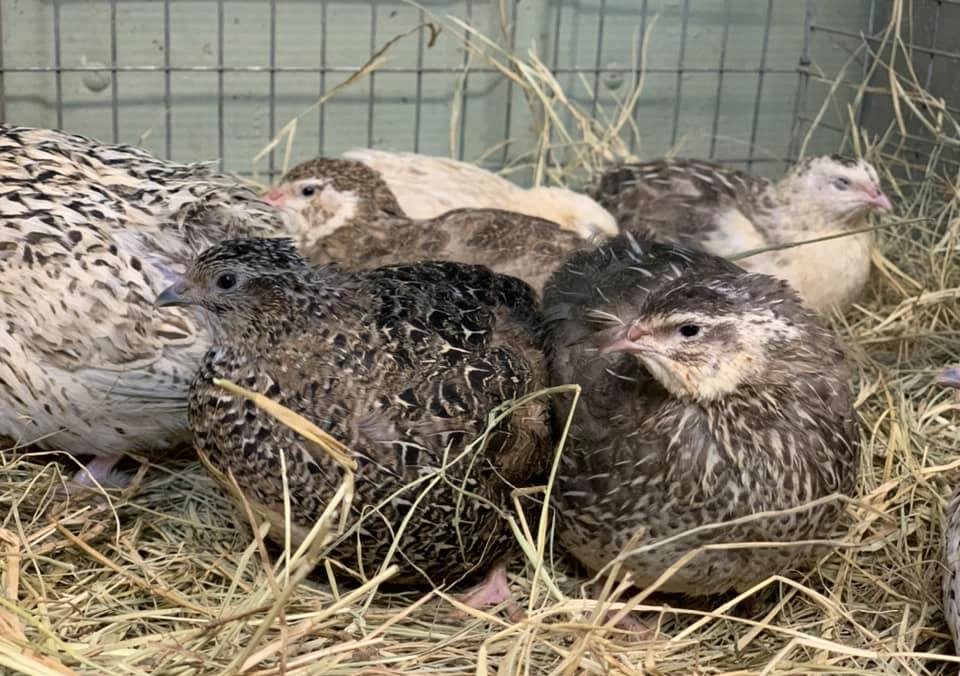In my experience, Coturnix quail are not just delicious to eat, but they are also easy to raise, and they produce plenty of eggs and meat for you and your family.
Coturnix quails are a smaller type of game bird. They are smaller than chickens or other fowl which makes them ideal for backyard farms. They are an excellent alternative poultry source.
Mature in just six weeks, this makes them efficient in terms of producing eggs and meat. They are low maintenance and don’t require a lot of space.
You can find Coturnix quail for sale in most areas, and they are relatively easy to raise. You can raise regular or jumbo Coturnix quail, depending if you raise them for eggs or meat.
This breed of quail is also called Japanese quail.
Raising Coturnix Quail
When raising quail, the thing to look out for is that these birds can be a little bit more fragile when they’re very young. This means you should consider getting them from a local breeder to start.
You can order hatching eggs to incubate yourself or buy live birds. You can also attend a live bird auction and purchase adult quail.
Although you can be successful ordering mail-order chicks, this is not always the case with Japanese Coturnix quail. You really want to ensure that they spend as little time as possible in transit. Check reviews before ordering.
Once you have your birds home, they should acclimate quickly. Quail don’t need very much space to roam around, so a small pen is sufficient.
Make sure it’s in a closed-off area to protect the quail from predators. Other than that, your quail should adjust perfectly to its new surroundings. Soon you will enjoy quail eggs.
In time, you can hatch baby quails yourself from fertile eggs the hens lay. You can also raise meat quail.
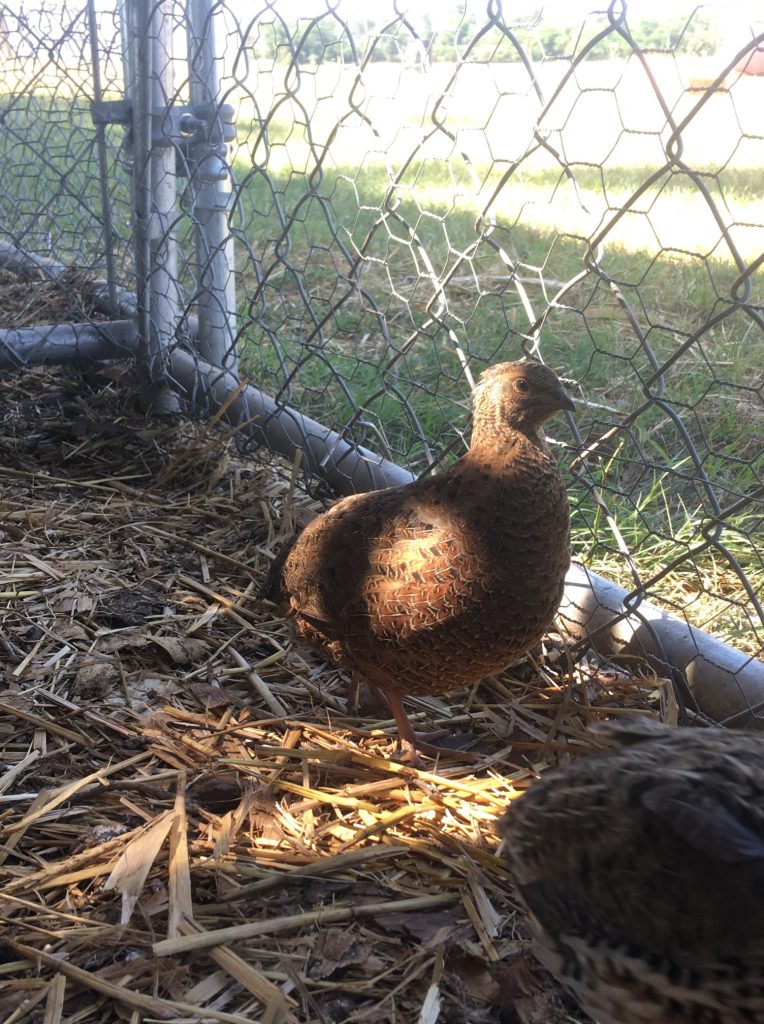
Purpose for Raising
They are dual-purpose meaning you can raise Coturnix quail for meat, eggs or both. It makes a lot of sense to raise them for both because Coturnix hens are prolific egg layers and will yield many tasty quail eggs throughout their lifetime.
I prefer to split them up myself, saving half to lay eggs and using the other half for meat. We’ll also hatch several throughout the year.
Coturnix Quail Eggs
If you are looking for good egg-laying birds, look no further than the Coturnix quail. These birds tend to hit their maturity very early and begin laying their eggs at only 8 weeks of age. Compare that to other types of quails, or chickens, who need to be five months old on average to start laying.
Japanese quail eggs weigh 10 – 14 grams each.
Coturnix hens lay regular eggs, and many will lay one per day for their entire lives. The only trick to ensuring consistent egg laying is to make sure that they get plenty of sunlight.
This type of quail must have 14 hours of daylight or artificial light every day. This means that if you live in a colder climate, or one without as much sunlight, you need to provide Coturnix with an artificial light source.
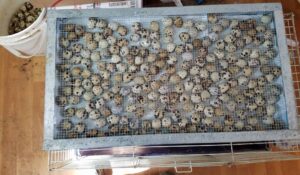
Meat
Coturnix quail are excellent meat birds because they grow extremely quickly and have large breasts. If you’re raising your quail for meat, you can start to harvest it after about seven weeks, when they reach full maturity.
As a main course, plan for a minimum of one quail per person.
Compare that to other types of quail, like the Bobwhite quail, which reaches maturity after 17 weeks, and you can easily understand the appeal of Coturnix.
Male quail average weight is 3.5 ounces – 5 ounces. Female quail weigh 4 – 6 ounces.
If you are raising birds for meat, you should consider raising Jumbo Coturnix. They were bred to be meat birds. You can enjoy the meat fresh or freeze it.
Jumbo Japanese quail are 8.8 ounces to 11 ounces and can reach 14 ounces at butcher weight. As a main course, plan for a minimum of one quail per person.
Hatching Coturnix Chicks
If your quail are laying eggs for chicks, as opposed to edible eggs, they only have to incubate about 17 days before the chicks hatch. That’s a lot quicker than what you get with chicken eggs, and you can quickly replenish your quail stock if you decide to use a few birds for butchering.
Domestic quail aren’t broody so you’ll need a still air incubator.
Keep one male Coturnix with 3 – 5 hens per cage. This way, you’ll help ensure they lay fertile eggs while also minimizing aggression and fighting.
Even if you don’t plan to hatch quail, the male quails will fight. Keep one per cage.
When raising Coturnix quail chicks, know that baby quail are fragile and need gentle handling.
You should put a sponge in their water dish to avoid accidental drowning and give them plenty of paper towels to nest in. They will also need a small box, heat lamp, and food.
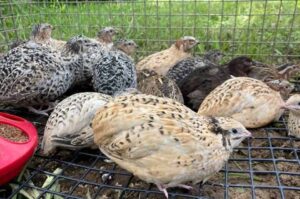
How to Raise Coturnix Quail
Light
Coturnix quail must have 14 hours of daylight or artificial light every day. This means that if you live in a colder climate, or one without as much sun, you need to provide quails with an artificial source.
Keep this in mind when deciding where to locate their shelter or cages.
Shelter
Unlike chickens, you do not need to give them nest boxes. Coturnix quails can lay right in their coop or cage, although it is advisable to have some easy method to collect the eggs.
Something as simple as a sloped floor can easily allow you to scoop up the eggs without breaking any. Since Coturnix quail eggs are small, make sure that you tread carefully in their coops. You don’t want to risk breaking an egg.
Just be sure to protect them from weather, including keeping them warm and dry. This includes shaded areas and an overall ventilated space.
Secure Enclosure
Unlike some varieties of chickens or other quail, Coturnix quail do not do well as free-range birds. They are far too vulnerable to predators, and they can easily escape.
These animals also tend to get spooked relatively quickly, and you could lose your stock if you let them have free range of your yard.
They are tiny and can fly, so it’s better to keep them in an enclosed pen.
If you want to give them a little extra freedom, make sure that their enclosure is fully encased in tight wiring to keep predators out and your quail from flying the coop.
Some people keep their quail indoors, especially in basements during the winter. Although this is an ideal way to keep them warm, it does pose problems with natural light and cleanliness.
Quail like being outdoors and benefit from fresh air and natural sunlight.
Fortunately, they are small enough to house in several different fashions.
Coop or Cage
I’ve experimented with housing for my Japanese quail and find that rabbit cages work exceptionally well. You just have to fix them up so that the quail’s feet don’t get stuck in the wire floor. Adding layers of newspaper or cardboard will resolve this and will also make their cages easy to clean.
Quail prefer to be closer to the ground, so it’s good to create housing that lets them be entirely in their natural habitat. They do not roost like chickens do.
Coturnix quail feel most secure when they have ample places to hide, so make sure that you stock their cages or crates with plenty of straw that they can burrow in. They might also prefer to use this straw as a viable place to lay their eggs.
Generally speaking, you need one square foot of space per Coturnix quail, with about ten inches of room for them to fly up if they want to. Some people prefer giving them a few feet. It’s really up to you and the layout of your yard.
Mature quail do well on decks and outdoors, as long as they have a lot of protection from the elements and predators. To protect your flock, use hardware cloth.
Keeping them inside is also an option, but you do need to provide enough fresh air for your quail. They love basking in the sun and might even experience a bit of depression if they are cooped up for too long.
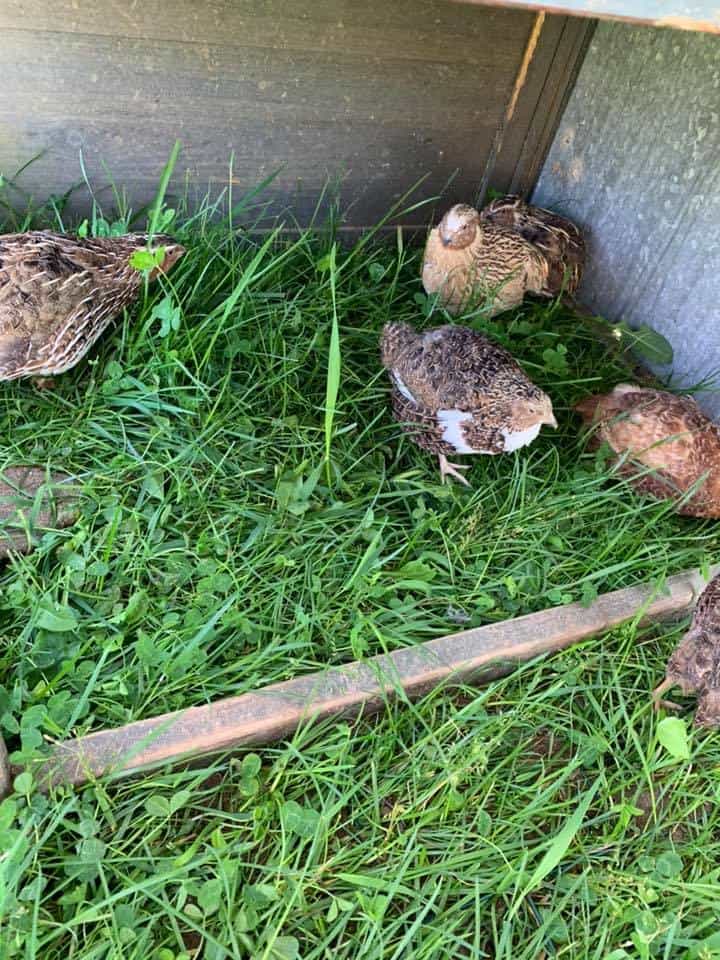
Heat Source
If you live in a colder climate, be sure to provide a heat source for them. In addition to being protected from the elements, they should have heat. This may be extra straw or artificial heat source.
Be sure it’s not too hot (quail are moving away from it) or that they are too cold (all of them crowding around it).
What to Feed Coturnix Quail
Coturnix do best with a nutritious diet that’s full of protein and free of fillers and chemicals. If you want the best eggs and meat, you need to feed your birds the best game bird feed you can find. You really do get out what you put into it.
Go to a reputable feed store in your area. Choose game bird feed for quail. If they don’t have that, choose a high protein feed for game birds. It should contain 24 – 30 percent protein.
After they are two months old, you can lower the protein content to 18%.
You can buy a generic game bird feed, as long as it’s high in protein and chemical-free. Don’t choose chicken feed as quail require more protein.
If you are raising Coturnix quail for eggs, be sure their diet includes calcium.
If you are feeding other poultry in your flock, such as ducks and turkey, you can use a multi-flock crumble as well.
You can also make your own quail food (though we do not do this). Make sure that it includes a combination of:
- Suet
- Carbohydrates
- Protein
If you’re confused about the best food to feed Coturnix, ask someone local who also raises them. It’s okay to experiment with different types of food in the beginning.
Also, monitor your quails’ health and leavings. If their diet doesn’t agree with them, you should see signs of it in their poop.
Fresh Water
They’ll also require clean, cold water daily. You can use a standard chicken waterer for quail.
Sexing Coturnix Quail
Determining the sex of your Coturnix quail is relatively easy. You can often tell from their color pattern. Male and female birds develop different colorations by about a month old, and some even sooner than that.
Sometimes you can tell the difference between the two by looking at their feathers. Female Coturnix quail will have speckled feathers, and male birds won’t.
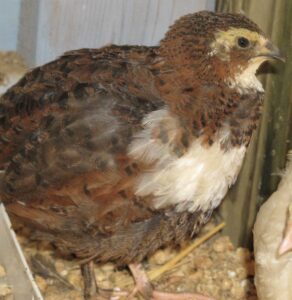
Also, depending on the variety of Coturnix you raise, you can determine their gender.
As an example, with all white Coturnix varieties, it will be difficult to determine. There aren’t color differences between the females and males. Breeders won’t guarantee the sex.
However, male quail begin mating calls around six weeks of age, so if you have white Coturnix quail, you can always sex them this way.
Like with the white Coturnix, with Tuxedo variety, there aren’t color difference either. When the chest has markings, it is difficult to sex them.
Jumbo Brown, Wild Type, and Pharaoh are sexable. The females will have spots on their chest. Within 14 – 21 days, you can determine the sex.
Calico Coturnix and Pharaoh Light, the males will have a beak and face mask that’s dark brown. Females won’t have face masks and they’ll have lighter-colored beaks. They also won’t have chest spotting.
You can sex a Manchurian Golden easily within 21 days. The males will have a light or dark face mask.
Coturnix Quail Colors
There are many color variations with different feather patterns. Assorted colors include all white to a mix of cream and tan, caramel, cinnamon, light brown, medium brown, and dark chocolate. They can have a predominant color or equal coloring throughout their feathers.
One of the most common types is the Pharaoh with brown feathers. This is what you’ll see in the wild.
English White are all white, including their chest feathers. Other white varieties are Panda, Pied and Marked. These Coturnix are mostly white and have a splattering of brown coloring on their back feathers, heads, and/or faces.
Tuxedo Coturnix have a combination of darker brown and white coloring. Calico Coturnix have almost a dark white with some speckling of browns and darker brown.
You can spot a Manchurian Golden quail because it will have vibrant gold and orange darker feathers. If they have speckles, there will be only a few.
Coturnix Chick Colors
The Jumbo Brown, Wild Type, and Pharaoh chick breeds are warm yellow and brown with dark brown and black stripes.
Calico Dilute chicks are yellow with silver stripes.
Manchurian Golden chicks are light yellow with thin dark stripes.
Jumbo Coturnix Quail
There are two types of Coturnix quail, jumbo and regular.
The Jumbo quail breed was bred for meat production. These meat birds can be up to twice as big as your regular-sized quail. They also tend to grow really fast, especially the Jumbo Brown Coturnix quail variety.
Jumbo quail can weigh up to 14 ounces, which is much larger than regular quail, who reaches roughly six ounces.
Like regular Coturnix quail, jumbo quail can fly and will flee their habitat if they’re frightened or have the chance. You should always make sure to fully enclose their habitat both for regular and jumbo quail.
Lifespan
Both jumbo and regular quail can live to about six years in captivity. Still, these domestic fowl generally don’t live that long, either because they are used for meat, they fall prey to predators, or other factors shorten their lifespans.
They are fairly disease resistant.
These birds are an off-shoot of Old World quails, popularized in parts of Africa, Australia, New Zealand, and Eurasia, and they’ve recently made the leap across the pond to the United States.
Good Beginner Birds
Coturnix quail are quite good for people just getting into raising birds. Decide whether you want to start with baby birds or adult birds.
When we first got our quail, we were a little bit worried because the birds were so fragile. Fortunately, we realized that these birds are friendly, engaging animals that are pretty easy to care for.
You can raise a flock of quail in your backyard. They don’t require much beyond a secure shelter and nice place to sleep, a little bit of hay, light, some high-quality food and fresh, clean water.
Depending on your space, you can determine the best type of coop.
Since they lay eggs regularly, they are great birds for teaching children about animal husbandry. You can send your kids out to collect Coturnix eggs regularly, feed the birds, and learn about their habits.
Another positive is that unlike chicken roosters, male quails’ crows are quieter making them ideal if you don’t live in a rural area.
Coturnix quail make a fantastic alternative to chickens or other game birds and are ideal for smaller plots of land or people with limited time to care for animals. As long as you provide them with adequate shelter, you can care for these game birds in any different type of climate and cherish your flock for years.

